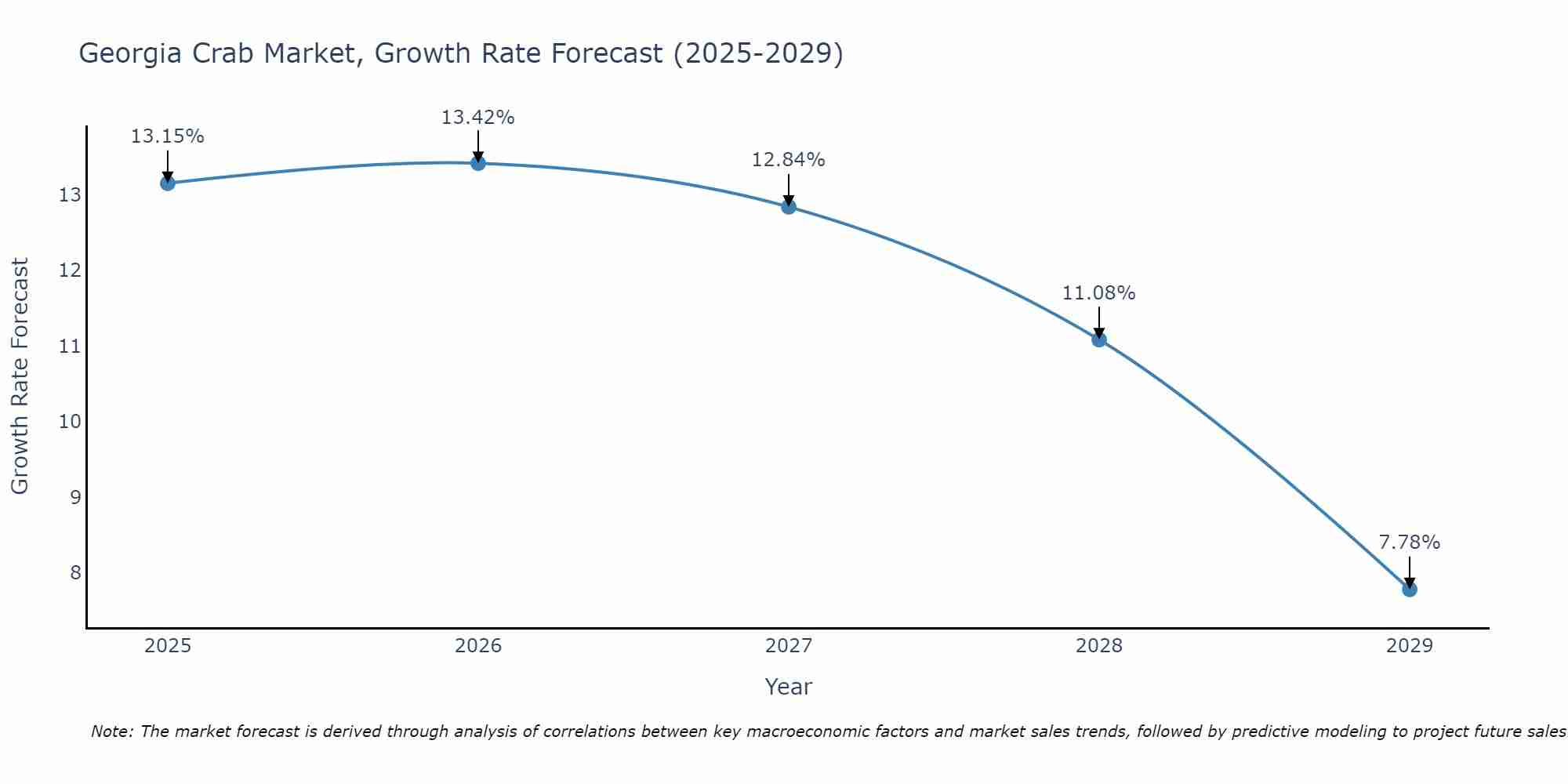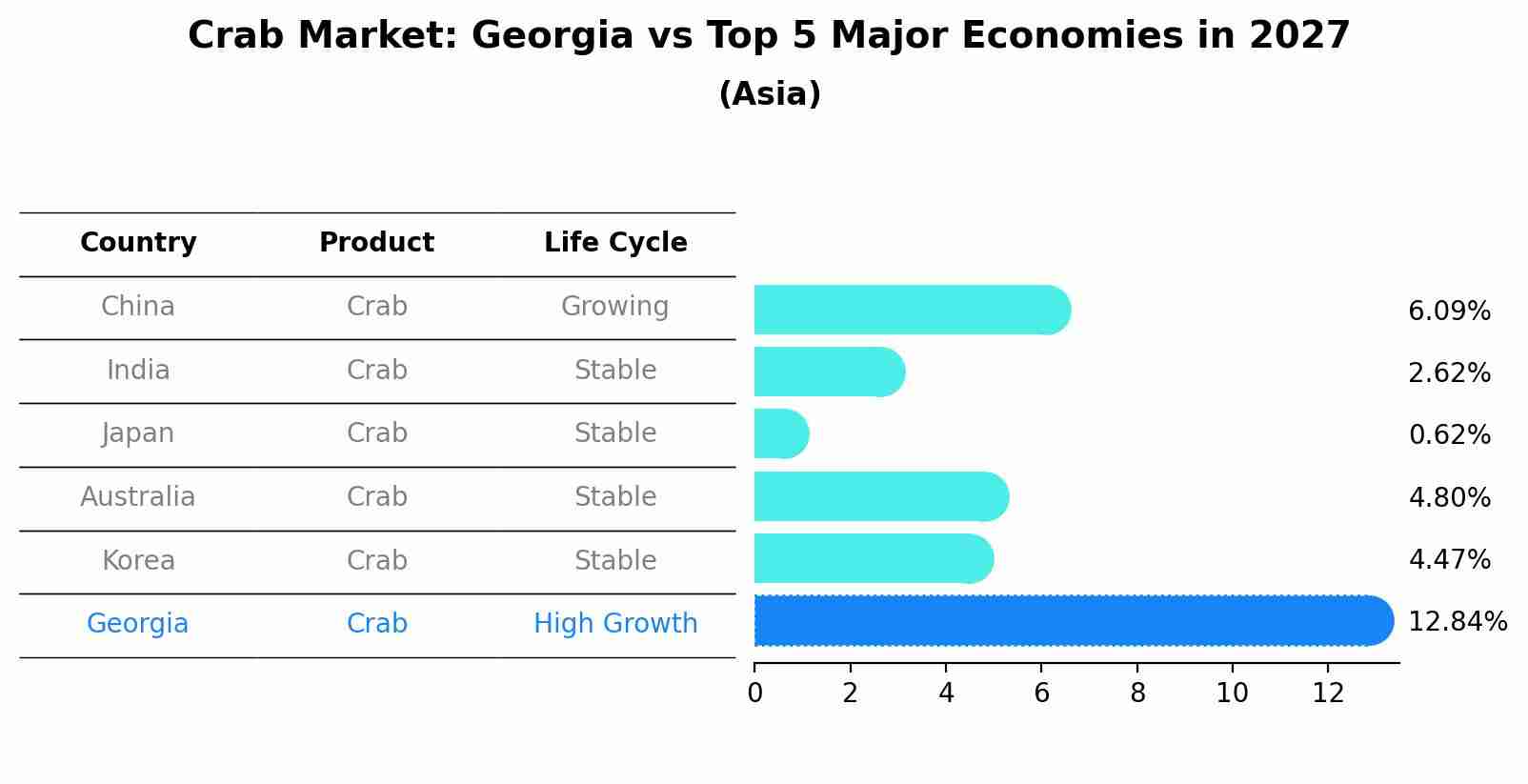Georgia Crab Market (2025-2031) Outlook | Companies, Value, Trends, Revenue, Analysis, Share, Forecast, Growth, Industry & Size
| Product Code: ETC088879 | Publication Date: Jun 2021 | Updated Date: Jun 2025 | Product Type: Report | |
| Publisher: 6Wresearch | Author: Bhawna Singh | No. of Pages: 70 | No. of Figures: 35 | No. of Tables: 5 |
Georgia Crab Market Size Growth Rate
The Georgia Crab Market is projected to witness mixed growth rate patterns during 2025 to 2029. Growth accelerates to 13.42% in 2026, following an initial rate of 13.15%, before easing to 7.78% at the end of the period.

Crab Market: Georgia vs Top 5 Major Economies in 2027 (Asia)
By 2027, the Crab market in Georgia is anticipated to reach a growth rate of 12.84%, as part of an increasingly competitive Asia region, where China remains at the forefront, supported by India, Japan, Australia and South Korea, driving innovations and market adoption across sectors.

Georgia Crab Market Overview
The Georgia Crab Market is a thriving industry driven by high demand for fresh and locally sourced seafood. Blue crab, in particular, is a popular catch in Georgia`s coastal waters, with the state ranking among the top producers of blue crab in the United States. The market is characterized by a network of commercial crabbers who supply fresh crabs to local seafood markets, restaurants, and wholesalers. Consumers favor Georgia crabs for their sweet and delicate flavor, making them a staple in Southern cuisine. The market also benefits from tourism, as visitors to coastal Georgia seek out authentic seafood experiences. Overall, the Georgia Crab Market showcases a strong connection between the local fishing community, culinary traditions, and consumer preferences for high-quality, sustainably sourced seafood.
Georgia Crab Market Trends
The Georgia Crab Market is currently experiencing a trend towards sustainable sourcing and increased demand for premium, locally sourced crabs. Consumers are increasingly seeking out wild-caught Georgia blue crabs due to their superior quality and taste. There is also a growing interest in supporting local fishermen and businesses, leading to a rise in sales of Georgia crabs at farmer`s markets and seafood markets. Additionally, there is a focus on transparency in the supply chain, with consumers wanting to know where their crabs are coming from and how they are caught. Overall, the Georgia Crab Market is seeing a shift towards sustainability, quality, and supporting local producers.
Georgia Crab Market Challenges
The Georgia Crab Market faces several challenges, including fluctuating crab populations due to environmental factors such as habitat loss and climate change. This variability in supply can lead to inconsistent availability and pricing of crabs for consumers and businesses. Additionally, competition from imported crabs can impact the market share of locally sourced Georgia crabs. The industry also grapples with regulatory issues, such as fishing quotas and restrictions aimed at ensuring sustainability but which can sometimes hinder the ability of crabbers to meet market demand. Inconsistent quality standards and concerns about food safety also present challenges in maintaining consumer trust and confidence in Georgia crab products. Overall, navigating these challenges requires strategic planning, collaboration with stakeholders, and adaptation to changing market conditions in order to sustain the Georgia Crab Market.
Georgia Crab Market Investment Opportunities
The Georgia Crab Market presents promising investment opportunities due to increasing demand for seafood products and the unique appeal of Georgia blue crabs. Investors can consider opportunities in crab fishing and processing operations, seafood distribution, or even restaurant ventures that focus on serving crab dishes. Additionally, investing in sustainable crab harvesting methods and eco-friendly practices can attract environmentally conscious consumers and contribute to long-term profitability. By closely monitoring market trends, consumer preferences, and regulatory changes, investors can capitalize on the growing popularity of Georgia blue crabs and leverage their high quality and distinct flavor profile to achieve a competitive edge in the seafood industry.
Georgia Crab Market Government Policy
Government policies related to the Georgia Crab Market primarily focus on conservation and sustainability efforts to ensure the long-term viability of the crab population. The Georgia Department of Natural Resources has implemented regulations such as minimum size limits, seasonal restrictions, and gear restrictions to protect the crab population from overfishing and habitat degradation. Additionally, the government works closely with local crabbers to monitor and manage crab stocks through data collection and research initiatives. These policies aim to strike a balance between supporting the livelihoods of crabbers and ensuring the continued health of the crab population and the overall marine ecosystem in Georgia waters.
Georgia Crab Market Future Outlook
The future outlook for the Georgia Crab Market appears promising, driven by factors such as increasing consumer demand for seafood products, particularly in the United States. The market is expected to benefit from a growing preference for locally sourced and sustainable seafood options, with Georgia`s crab industry well-positioned to capitalize on this trend. Additionally, advancements in technology and fishing practices are likely to enhance the efficiency and sustainability of crab harvesting in the region, further supporting market growth. However, challenges such as environmental concerns, regulatory changes, and competition from other seafood sources may impact the market`s trajectory. Overall, the Georgia Crab Market is anticipated to experience steady growth in the coming years, driven by evolving consumer preferences and industry innovations.
Key Highlights of the Report:
- Georgia Crab Market Outlook
- Market Size of Georgia Crab Market, 2021
- Forecast of Georgia Crab Market, 2031
- Historical Data and Forecast of Georgia Crab Revenues & Volume for the Period 2021 - 2031
- Georgia Crab Market Trend Evolution
- Georgia Crab Market Drivers and Challenges
- Georgia Crab Price Trends
- Georgia Crab Porter's Five Forces
- Georgia Crab Industry Life Cycle
- Historical Data and Forecast of Georgia Crab Market Revenues & Volume By Type for the Period 2021 - 2031
- Historical Data and Forecast of Georgia Crab Market Revenues & Volume By Blue Crab for the Period 2021 - 2031
- Historical Data and Forecast of Georgia Crab Market Revenues & Volume By Chinese Mitten Crab for the Period 2021 - 2031
- Historical Data and Forecast of Georgia Crab Market Revenues & Volume By Gazami Crab for the Period 2021 - 2031
- Historical Data and Forecast of Georgia Crab Market Revenues & Volume By Others for the Period 2021 - 2031
- Historical Data and Forecast of Georgia Crab Market Revenues & Volume By Form for the Period 2021 - 2031
- Historical Data and Forecast of Georgia Crab Market Revenues & Volume By Frozen for the Period 2021 - 2031
- Historical Data and Forecast of Georgia Crab Market Revenues & Volume By Canned for the Period 2021 - 2031
- Historical Data and Forecast of Georgia Crab Market Revenues & Volume By Others for the Period 2021 - 2031
- Georgia Crab Import Export Trade Statistics
- Market Opportunity Assessment By Type
- Market Opportunity Assessment By Form
- Georgia Crab Top Companies Market Share
- Georgia Crab Competitive Benchmarking By Technical and Operational Parameters
- Georgia Crab Company Profiles
- Georgia Crab Key Strategic Recommendations
Frequently Asked Questions About the Market Study (FAQs):
1 Executive Summary |
2 Introduction |
2.1 Key Highlights of the Report |
2.2 Report Description |
2.3 Market Scope & Segmentation |
2.4 Research Methodology |
2.5 Assumptions |
3 Georgia Crab Market Overview |
3.1 Georgia Country Macro Economic Indicators |
3.2 Georgia Crab Market Revenues & Volume, 2021 & 2031F |
3.3 Georgia Crab Market - Industry Life Cycle |
3.4 Georgia Crab Market - Porter's Five Forces |
3.5 Georgia Crab Market Revenues & Volume Share, By Type, 2021 & 2031F |
3.6 Georgia Crab Market Revenues & Volume Share, By Form, 2021 & 2031F |
4 Georgia Crab Market Dynamics |
4.1 Impact Analysis |
4.2 Market Drivers |
4.3 Market Restraints |
5 Georgia Crab Market Trends |
6 Georgia Crab Market, By Types |
6.1 Georgia Crab Market, By Type |
6.1.1 Overview and Analysis |
6.1.2 Georgia Crab Market Revenues & Volume, By Type, 2018 - 2027F |
6.1.3 Georgia Crab Market Revenues & Volume, By Blue Crab, 2018 - 2027F |
6.1.4 Georgia Crab Market Revenues & Volume, By Chinese Mitten Crab, 2018 - 2027F |
6.1.5 Georgia Crab Market Revenues & Volume, By Gazami Crab, 2018 - 2027F |
6.1.6 Georgia Crab Market Revenues & Volume, By Others, 2018 - 2027F |
6.2 Georgia Crab Market, By Form |
6.2.1 Overview and Analysis |
6.2.2 Georgia Crab Market Revenues & Volume, By Frozen, 2018 - 2027F |
6.2.3 Georgia Crab Market Revenues & Volume, By Canned, 2018 - 2027F |
6.2.4 Georgia Crab Market Revenues & Volume, By Others, 2018 - 2027F |
7 Georgia Crab Market Import-Export Trade Statistics |
7.1 Georgia Crab Market Export to Major Countries |
7.2 Georgia Crab Market Imports from Major Countries |
8 Georgia Crab Market Key Performance Indicators |
9 Georgia Crab Market - Opportunity Assessment |
9.1 Georgia Crab Market Opportunity Assessment, By Type, 2021 & 2031F |
9.2 Georgia Crab Market Opportunity Assessment, By Form, 2021 & 2031F |
10 Georgia Crab Market - Competitive Landscape |
10.1 Georgia Crab Market Revenue Share, By Companies, 2021 |
10.2 Georgia Crab Market Competitive Benchmarking, By Operating and Technical Parameters |
11 Company Profiles |
12 Recommendations |
13 Disclaimer |
- Single User License$ 1,995
- Department License$ 2,400
- Site License$ 3,120
- Global License$ 3,795
Search
Thought Leadership and Analyst Meet
Our Clients
Related Reports
- Afghanistan Apparel Market (2026-2032) | Growth, Outlook, Industry, Segmentation, Forecast, Size, Companies, Trends, Value, Share, Analysis & Revenue
- Canada Oil and Gas Market (2026-2032) | Share, Segmentation, Value, Industry, Trends, Forecast, Analysis, Size & Revenue, Growth, Competitive Landscape, Outlook, Companies
- Germany Breakfast Food Market (2026-2032) | Industry, Share, Growth, Size, Companies, Value, Analysis, Revenue, Trends, Forecast & Outlook
- Australia Briquette Market (2025-2031) | Growth, Size, Revenue, Forecast, Analysis, Trends, Value, Share, Industry & Companies
- Vietnam System Integrator Market (2025-2031) | Size, Companies, Analysis, Industry, Value, Forecast, Growth, Trends, Revenue & Share
- ASEAN and Thailand Brain Health Supplements Market (2025-2031) | Strategy, Consumer Insights, Analysis, Investment Trends, Opportunities, Growth, Size, Share, Industry, Revenue, Segments, Value, Segmentation, Supply, Forecast, Restraints, Outlook, Competition, Drivers, Trends, Demand, Pricing Analysis, Competitive, Strategic Insights, Companies, Challenges
- ASEAN Bearings Market (2025-2031) | Strategy, Consumer Insights, Analysis, Investment Trends, Opportunities, Growth, Size, Share, Industry, Revenue, Segments, Value, Segmentation, Supply, Forecast, Restraints, Outlook, Competition, Drivers, Trends, Demand, Pricing Analysis, Competitive, Strategic Insights, Companies, Challenges
- Europe Flooring Market (2025-2031) | Outlook, Share, Industry, Trends, Forecast, Companies, Revenue, Size, Analysis, Growth & Value
- Saudi Arabia Manlift Market (2025-2031) | Outlook, Size, Growth, Trends, Companies, Industry, Revenue, Value, Share, Forecast & Analysis
- Uganda Excavator, Crane, and Wheel Loaders Market (2025-2031) | Strategy, Consumer Insights, Analysis, Investment Trends, Opportunities, Growth, Size, Share, Industry, Revenue, Segments, Value, Segmentation, Supply, Forecast, Restraints, Outlook, Competition, Drivers, Trends, Demand, Pricing Analysis, Competitive, Strategic Insights, Companies, Challenges
Industry Events and Analyst Meet
Whitepaper
- Middle East & Africa Commercial Security Market Click here to view more.
- Middle East & Africa Fire Safety Systems & Equipment Market Click here to view more.
- GCC Drone Market Click here to view more.
- Middle East Lighting Fixture Market Click here to view more.
- GCC Physical & Perimeter Security Market Click here to view more.
6WResearch In News
- Doha a strategic location for EV manufacturing hub: IPA Qatar
- Demand for luxury TVs surging in the GCC, says Samsung
- Empowering Growth: The Thriving Journey of Bangladesh’s Cable Industry
- Demand for luxury TVs surging in the GCC, says Samsung
- Video call with a traditional healer? Once unthinkable, it’s now common in South Africa
- Intelligent Buildings To Smooth GCC’s Path To Net Zero


















